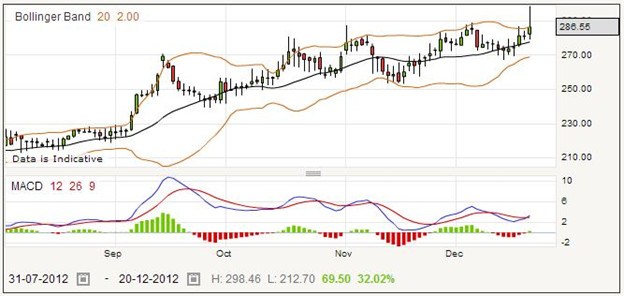Jupiter Fund Management is a major fund management company, winner of several awards, and managing funds for both private and institutional investors. The daily stock price chart below shows good volatility up and down, which for spread betting is an advantage.

The company started in 1985, but has had an extensive history since then. It was sold to a German bank in two lots, in 1995 and 2000, and this precipitated the founder’s leaving to set up a new group. The head of the fund now is Edward Bonham Carter, brother of the actress Helena Bonham Carter. There was a management buyout in 2007 which gave ownership to the company staff, and away from the German bank. But in 2010, the company was floated on the London Stock Exchange, thus its record on the LSE is fairly short. The staff retained a minority shareholding.
The fund has assets in international and UK funds and companies, as well as the specialist equity portfolios. It has expanded its reach into the international investor market since 2007, picking up investors from countries such as Austria, France, Singapore, and Germany. The total amount of money under management is about £24 billion.
As a fund management company, with dealings in other funds and in shares, Jupiter is vulnerable to any market crashes as with any other financial company. However, with good current performance the company should generally continue on an uptrend. The volatility shown in the chart above is encouraging for spread trading, as profit is to be made from changing prices whether up or down, and not from sideways price movement.
Because the up and down trends shown on the chart tend to last only a week or two, this share may be better spread traded on a smaller time scale, such as a two hour or four hour chart. This would give you time to identify a trend and be able to bet for a reasonable profit.
Jupiter Fund Management Rolling Daily: How to Spread Bet on Jupiter Fund Management Shares?
Given its recent performance, you will need to look carefully at the technicals of the share to determine which direction to bet. Say after due consideration you decide to place a short bet on a daily rolling basis, you might choose to stake £20 per point. The current quotation for a rolling daily bet is 272.12 – 273.48.
If the price goes down to 251.12 – 252.48 and you decide to collect your profit, then you can work out how much you made like this. The opening price for your sell bet was 272.12, and you closed the bet at 252.48. That means you have gained the difference, 19.64 points. You chose to stake £20 per point. Multiplying this by the point gain, you would have won £392.80.
With the financial markets, it is hard to predict which direction the price will go. Suppose the price went up after you placed your short bet, you might choose to cut your losses when the quote went up to 284.72 – 286.08. In that case, you would have closed your bet at 286.08. Taking away the starting price of 272.12 you would find that you have lost 13.96 points. Multiplying this by £20, your losses work out to £279.20.
Many spread traders use a stop loss order to control their bets. This requires your spread betting company to close your bet if it reaches a level of loss that you set in advance. If you had used one on this, your bet might have closed at 278.42 – 279.78. That means your closing price would be 279.78, the buying price. Taking away the opening price of 272.12, your loss in points this time would be 7.66. You decided to stake £20 per point, which means that you have lost 7.66 times £20, or £153.20.
Jupiter Fund Management Futures Style Bet
With a futures style bet, there are no rollover charges and you can hold the bet open until the expiration date, which in the case of the far quarter futures is 7 to 9 months away. Perhaps you decide to place a long bet on the far quarter for the Jupiter Fund, for which the current price is 272.58 – 275.87. You choose to stake £12 per point.
Suppose the price goes up to 304.08 – 307.37. If you close the bet now, it will close at 304.08, the selling price. You opened the bet at the buying price of £275.87. Therefore you have gained 304.08-275.87 points, which works out to 28.21 points. Multiplying this by your stake of £12 per point, your total gain is £338.52.
Because the financial markets are difficult to predict, many times you will find that the price goes in the wrong direction for your bet, and you will be faced with closing your trade for a loss to avoid further damage. You might choose to do that on this bet if the price dropped to 259.98 – 263.27. Your bet opened at a price of 275.87, and it closed at a price of 259.98. 275.87 minus 259.98 is 15.89 points. 15.89 times £12 works out to a loss of £190.68.
Many spread betters use a stop loss order to protect themselves from a large loss. If you cannot watch the market all the time, the stop loss order works well, requiring your spread betting provider to close your losing bet if it reaches a certain point. The stop loss order on this bet might have closed it when the quote was 266.28 – 269.57. With an opening price of 275.87 and a closing price of 266.28, this bet would have lost 9.59 points. Because your stake was £12 per point, this works out to an overall loss of £115.08.